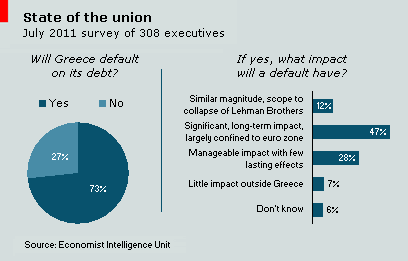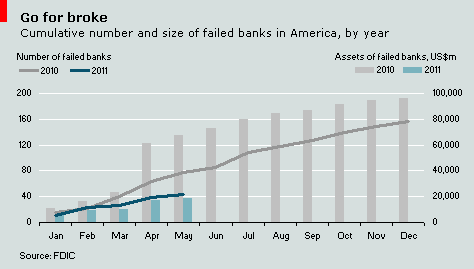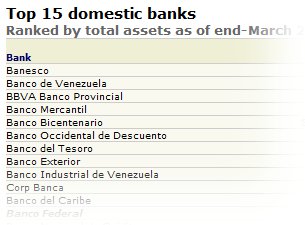You are currently browsing the tag archive for the ‘bankruptcy’ tag.
A new survey of executives by the Economist Intelligence Unit adds another perspective to the all-but-inevitable event roiling financial markets: a Greek default. Nearly three-quarters of more than 300 executives polled by the EIU over the past week believe that Greece will eventually default on its debt. (For the full survey results, visit the EIU’s Business Research site.)
On Monday, euro area finance ministers released a statement calling for a “broader and more forward-looking policy response” to Greece’s ongoing struggles with its crushing debt burden. On the same day, Greek prime minister George Papandreou added his thoughts on the matter, warning that “if Europe does not make the right, collective, forceful decisions now, we risk new, and possibly global, market calamities due to a contagion of doubt that will engulf our common union.”
In the EIU’s survey, a small but noteworthy minority of respondents, 12%, think that the impact of a Greek default will be of a similar scale and magnitude of the collapse of Lehman Brothers in 2008. A larger share of executives, 47%, predict a significant, long-lasting impact, but with the pain largely confined to the euro area. The remaining respondents either expect little impact or weren’t willing to hazard a guess.
With Greece’s benchmark bonds trading at half of face value, and spreads for Spain and Italy recently touching euro-era highs, officials are scrambling to stem the contagion from the monetary union’s troubled periphery. There is talk of an emergency euro summit on Friday, when release of the EU’s bank stress tests could destabilise markets further. But true to form, euro area officials are finding it difficult to come to an agreement on whether to meet or not.

On June 3rd, Atlantic Bank and Trust of Charleston, South Carolina became the 45th bank in the US to fail this year. After a brief period in receivership under the control of the Federal Deposit Insurance Corporation, the lender’s assets—worth US$208m—were transferred to First Citizens Bank and Trust.
This is not an unusual occurrence: 367 banks have failed since 2008. But the pace of failures so far this year is slower than in 2010. And only five banks failed in May, which some see as an “encouraging milestone”. Recall, however, that three banks failed in March, promptly followed by 13 in April, the highest monthly tally since last spring.
More encouraging is that the size of failed banks so far this year is significantly smaller than last year—an average of US$430m in assets per bank through May this year, versus US$867m over the same period in 2010.

The majority of data and analysis at Financial Services Briefing is available only to subscribers. Each week, a small share of content from the service is made available to non-subscribers.

Although a reckoning was overdue, the suddenness of South Korea’s suspension of eight savings banks was surprising. Signs of strain at the small, community-based lenders were long apparent; heavy exposure to the property industry put loan portfolios at risk as construction activity cooled and housing prices stagnated. Nevertheless, the suspensions of one bank last month and seven so far this month has generated drama, and some fear, in the country.
The recent suspensions were the first such actions taken against savings banks by the Financial Services Commission (FSC), South Korea’s financial industry watchdog, since October 2000, when 17 savings banks were forcibly shut down. The FSC issued “corrective” orders to wayward savings banks in the intervening years, but the severity of shortcomings at some lenders required more drastic measures. The suspension of Samwha Mutual Savings Bank last month spooked savers, who hastily withdrew billions of won from other savings banks, leading to a further seven suspensions (including Busan Savings Bank, the country’s largest savings bank).
Read more at Financial Services Briefing: “Big trouble at little lenders” (February 24th)
Between 2008 and 2010, 72 financial institutions rated by Moody’s defaulted on bonds worth US$318bn. From 1983 to 2007, there were 96 financial defaults, affecting “only” US$46bn in debt.

Given the severity of the recent crisis, it follows that the prospects of recovery for creditors were dim. Indeed, loan holders recovered far less from defaulted debt during the recent crisis than over the previous 20+ years. On bonds, however, recovery rates were little changed from before. A larger than usual share of distressed exchanges—a discounted repurchase of bonds or substitution for a new set of securities—explains the boost to recoveries during the latest crisis (30% of 2008-10 defaults versus 10% in 1983-2007). In other words, creditors took what they could get from teetering banks before the borrowers went bust and potentially left them with nothing.
In the context of Lehman Brothers’ mammoth bankruptcy, US$1bn is not a lot of money. Still, it is noteworthy that the administrators of the American arm of the collapsed bank’s estate recently passed the billion-dollar mark when it comes to the fees paid to the army of lawyers, consultants and other advisors over the past two years (US$1,013,116,000 to be precise). The details can be found in a filing made in advance of a hearing on October 20th in bankruptcy court (direct linking is difficult; go here and look for docket no. 12082.) As Bloomberg points out, the fees work out to US$1.3m per day, which may seem steep when creditors are in line to receive 16 cents on the dollar.

New research from the New York Federal Reserve attempts to shed some light on the so-called shadow banking system, the vast network of lightly-regulated financial firms that failed spectacularly during the credit crunch. This is no easy task, as a series of headache-inducing flowcharts proves (a small excerpt from the paper’s coup de grace, on p3, is below; FT Alphaville, meanwhile, attempts to distil the paper’s findings in cartoon form). The paper itself is also somewhat mysterious, as the authors note that the first 70 pages are intended as an “executive summary” of a 230-page tome to which a full table of contents is provided but no further pages are published.
The Fed researchers define shadow banks as “financial intermediaries that conduct maturity, credit, and liquidity transformation without access to central bank liquidity or public sector credit guarantees.” At their peak, shadow banks amassed liabilities of nearly US$20trn, some US$8trn more than the traditional banking system. These intermediaries fuelled the subprime credit boom with cheap funds by converting “opaque, risky, long-term assets into money-like and seemingly riskless short-term liabilities,” the authors write. Of course, at the first signs of distress this seemingly riskless source of funds was found to be anything but.

The majority of data and analysis at Financial Services Briefing is available only to subscribers. Each week, a small share of content from the service is made available to non-subscribers.

The Venezuelan bank regulator moved to shut down Banco Federal, a firm linked to the political opposition, on June 14th. The bank is owned by Nelson Mezerhane, a director and founder of Globovisión, the only remaining anti-Chávez television station.
The move to intervene and shutter Banco Federal follows half a year of closures of financial institutions. This touched first banks at the end of last year and the beginning of 2010, and has more recently affected brokerage firms. Unlike Banco Federal, most of the firms closed earlier were run by men closely associated with, but who seemed to fall foul of, the government of Hugo Chávez.
Read more at Financial Services Briefing: “Another private lender shuttered” (June 14th)
The majority of data and analysis at Financial Services Briefing is available only to subscribers. Each week, a small share of content from the service is made available to non-subscribers.
Demetrio Fernández is not a name that comes up often in international financial circles. But the bishop of Cordoba made headlines in the business press on May 22nd when CajaSur, a church-owned regional savings bank, or caja de ahorros, was seized by the Bank of Spain due to “viability problems”.

The CajaSur rescue, although affecting only 0.6% of the total assets of the Spanish banking system, rattled already jittery markets. With heavy exposure to Spain’s battered property market and limited recourse to external funds, the cajas represent worrying “pockets of weakness” in the Spanish financial system, according to the IMF.
Given Spain’s dire fiscal state, it needs the explicit threat of seizure of uncooperative lenders to speed the long-delayed restructuring of the beleaguered cajas. However, the risk remains that the savings banks lack the collective will to fix themselves.
Read more at Financial Services Briefing: “A dangerous precedent” (May 26th)
A deep recession has ushered in a new era of austerity in much of the west and, in some cases, threatened the solvency of some states. Even so, the direct cost of fixing the proximate cause of the crisis—the near-collapse of the banking sector—is modest by historical standards, argues Deutsche Bank in a recent report.

The initial commitments pledged by governments to support the financial sector reached 20-30% of GDP in major developed markets. Effective outlays, however, have amounted to only 3.5% of GDP for G20 countries, roughly equivalent to the cost of the Swedish banking bailout of the early 1990s.
Of course, the direct fiscal costs of the crisis—equity injections, debt assumed by the state and emergency liquidity support for banks—tell only part of the story. But given the broader economic damage wrought by the financial crisis, any shred of good news is welcome. In short, it could be worse.
 The administrators of Lehman Brothers’ assets in the US have spent more than US$640m on advisors since the bank filed for bankruptcy in September 2008. The latest progress report from the estate details the fees paid to a wide range of professional service firms, from restructuring specialists to lawyers to Kelly Matthew Wright, an auctioneer who’s collected US$47,000 thus far to help sell off Lehman’s corporate art collection.
The administrators of Lehman Brothers’ assets in the US have spent more than US$640m on advisors since the bank filed for bankruptcy in September 2008. The latest progress report from the estate details the fees paid to a wide range of professional service firms, from restructuring specialists to lawyers to Kelly Matthew Wright, an auctioneer who’s collected US$47,000 thus far to help sell off Lehman’s corporate art collection.
Alvarez & Marsal, a turnaround and restructuring firm, has profited the most from Lehman’s downfall, collecting US$233m in fees for interim management services. Among a phalanx of legal advisors, lead firm Weil, Gotshal & Manges came out on top, billing US$150m through January. According to Corporate Counsel, that works out to around US$300,000 per day. Nice work if you can get it.

